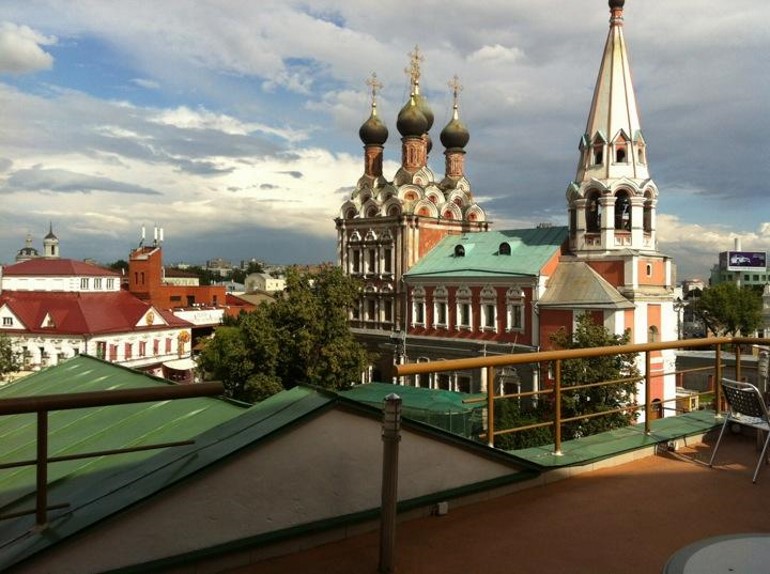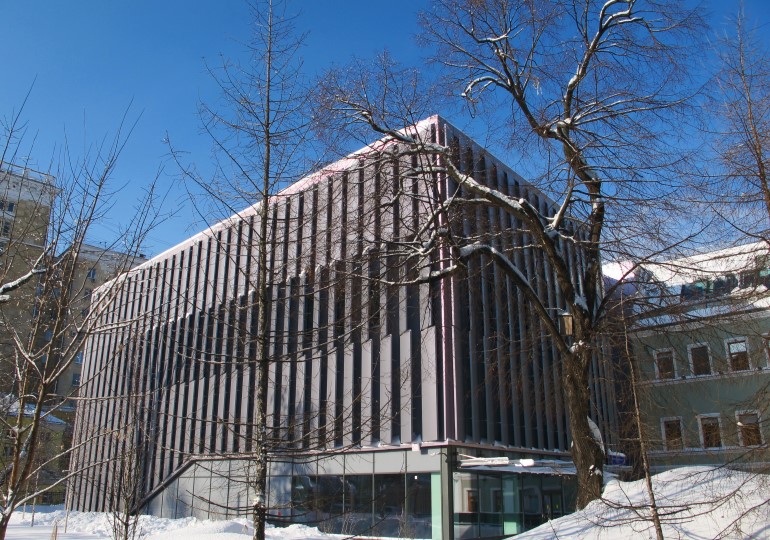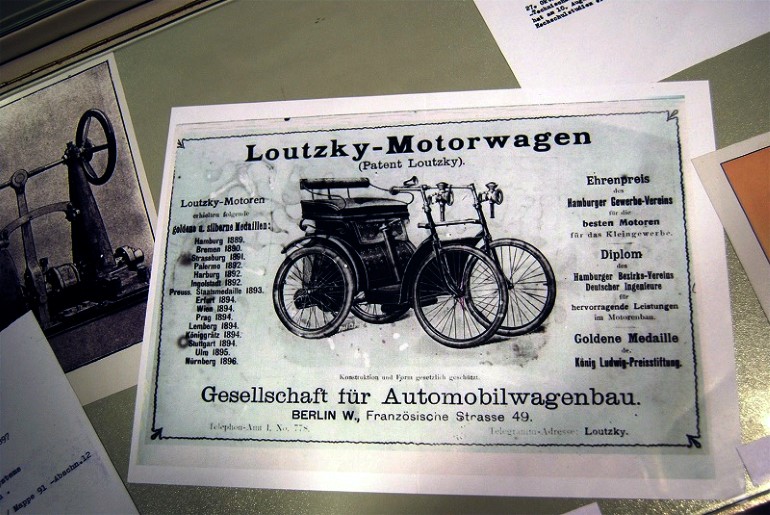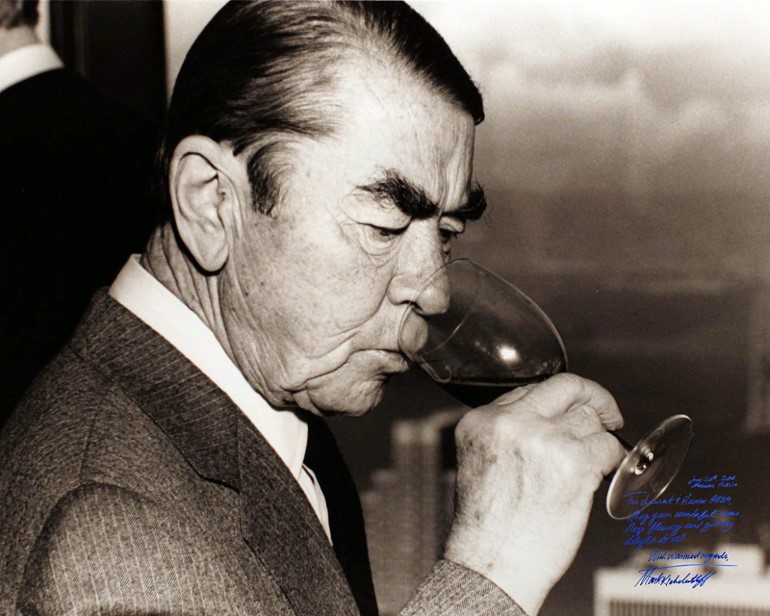The Solzhenitsyn House of Russia Abroad, panoramic view from the balcony
Svetlana Smetanina
Early this year the Solzhenitsyn House of Russia Abroad received the key to a new building, where the Museum of Russian Immigration is to open soon. Now is the hardest part of work, placing the exhibits so that they would “talk” to the visitors. Igor Domnin, the deputy director for the Solzhenitsyn House of Russia Abroad and Andrey Vovk, the director for the Russian branch of Ralph Appelbaum Associates are discussing the ways to do it.
How The Museum of Russian Immigration started
Igor Domnin, the Deputy Director for the Solzhenitsyn House of Russia Abroad says:
Since the very beginning, when supported by Moscow government the Solzhenitsyn House of Russia Abroad was initiated, Russian immigrants started to give us historic documents. Though, our top priority was collecting books. Alexander Solzhenitsyn asked the so-called older immigration to send him their evidence so that it did not perish with time. A few people needed it back in the USSR and nobody would have taken it anyway. Then Solzhenitsyn said: “send it to me, I’ll go back to Russia or my children will and we will create a centre, where we will collect the legacy of Russian Expatriate Community.”
When the House was created it became the centre where the legacy of Russian expatriate community is accumulated. What was meant by legacy here is, first of all, the printed or written words – archives and books. First, the library formed. Then archives started to turn up, people just brought them and gave them to us. The Solzhenitsyns, Alexander Isaevich and Natalia Dmitrievna formed the basis for the archive as they donated their famous All-Russian memoir library - the collection of manuscripts (or typescripts) they had received from the older immigration during the 20 years they had lived in the US.
Thanks to the efforts of director and one of the House’s founders V. A. Moskvin, followers of this trend were found soon. They set up their initiative groups, like The Books for Russia’s Committee in the US chaired by L. S. Flam-Obolenskaya. Then the descendants of the immigrants started to collect their legacy.
For ten years we collected mostly books, magazines, newspapers and archives. However, we occasionally got photo albums, which are rather museum exhibits, or personal belongings like a writer’s inkpot and a pen or a cane…
The need for a museum became obvious when we started holding exhibitions. First we demonstrated documents and books, then started to add objects and it turned out that people showed as much interest in the objects as they did in books, sometimes even more. Therefore, we started gathering the objects for the museum.
Shortly afterwards we initiated the Museum of Russian Immigration. As soon as we received the status of a museum, we began asking immigrants to donate not only documents and books but also artefacts.
The question of opening the Museum of Russian Immigration originated quickly. When we got the museum status, we started actively agitate and encourage the Russian immigrants to donate material evidence and not just documents and books.
The idea to create the museum was supported by the Russian President Vladimir Putin and the major of Moscow Sergei Sobyanin. Even though its implementation took quite a time, we received a wonderful fit-for-purpose building in December 2017.
Now it’s time for designers and specialists in exhibition setting to arrange the items we have collected in a way that would cast light on the versatile life of the Russian Expatriate Community, so that the artefacts could “come alive and talk” and open a dialogue with the visitors.
Building of The Solzhenitsyn House of Russia Abroad. Picture: bfrz.ru
"Telling about life of the Russian Expatriate Community is an incredibly hard task"
Andrey Vovk, the director for the Russian branch of Ralph Appelbaum Associates, the world’s largest company dealing with the museum design. Among the company’s projects are the National Holocaust Memorial in Washington, the National Museum of Scotland in Edinburgh, the Transport Museum in London, the Natural History Museum in Salt Lake City, the Museum of the Portugal Language in Sao Paulo and Yeltsin Centre in Yekaterinburg.
The new concept introduced by Ralph Appelbaum is a completely new approach to the space in the museum, where visitors enter the display. – Andrey says - This technique makes visitors be emotionally involved into the exposition. In the Holocaust Memorial, for instance, there is a part of an Auschwitz barrack and in the Yeltsin Centre there is a trolleybus that the first Russian president used.
Vovk himself has been an immigrant for 26 years. He has taught architecture in the US, Germany, the Netherlands and Austria. 10 years ago, he was invited to participate in designing the Jewish Museum and the Tolerance Centre in Moscow. Then there was the Yeltsin Centre in Yekaterinburg. According to Andrey, these projects can’t be compared to the current work on the Museum of Russian Immigration.
- The theme here is much more complex. We have focused mostly on the first wave of immigration. And even that includes a lot – the war and the civil life, the philosophic approach. Where they had gone and what they were doing there – all that accumulates into a huge volume of information. We have to tell the story of Russia abroad, which is an alternative Russia. Even if it is not a state, it is an incredible entity with everything - its own prints, books, schools and churches. This is a country outside of the country. Then, there is also a vast geography – Paris, Berlin, Shanghai, Australia, Latin America, and Africa. How can you cover all this? Geography is vast, the scope is unbelievable, the achievements are very impressive. Demonstrating all of them over 900 square metres is hardly possible.
Igor Domnin:
– Presenting the world of Russian Expatriate Community is not an easy task, because Russia abroad is a complex phenomenon. How should it be presented, from what point of view and what angle? After a long preliminary discussion between specialists managed by V. A. Moskvin it was decided to arrange the display based on the spheres (margins) of people’s life in immigration. This will stress the common features of the immigration world. All the places the Russian immigrants centred around were as like as two peas. These are churches as centres of spiritual life, Russian educational institutions, and powerful print media, with surprising abundance of newspapers, magazines and publishers. This was also active social life and very closely united Russian troops.
We will also show historical periods: the Civil War and its incredible tragedy. Then Russians' spreading, which covered the whole world. Then their daily routine – the way they lived, worked and earned for living. We want to demonstrate their spiritual needs in the first place. When these people did not even have a roof over their heads they already had mobile churches, published first hand-written newspapers and magazines. We show how they worked with children. Youth organizations involved all the immigrants’ children and youngsters later followed by their own children and grandchildren. There were Sunday schools teaching the Russian language in the places where there were not regular Russian schools. This was the whole educational system with proper Russian schools and gymnasiums.
A showpiece “Engineer B. G. Lutskiy – a genius of motorcar manufacturing of Europe” in the Solzhenitsyn House of Russia Abroad. Picture: museum-ic.ru
Naturally, we do not want to neglect the culture – the art, music, ballet, film industry. All this combined lets us hope that the visitors will see something unusual and discover something new. For a few people really understand how our Russian immigration was created, built, existed and how creative it was.
Besides, we will introduce outstanding public figures who made scientific discoveries or technological advancements, succeeded in the sphere of arts and culture. These are the people like Zvorykin and Sikorsky, Ipatyev and Ponyatov, Bunin, Shmelyev, Tsvetaeva, Berdyaev and Ilyin, Shalyapin and Rachmaninoff, Pavlova and Lifar, Korovin and Goncharova… It’s impossible to mention everyone – there were so many. We may as well mention the modern immigrants – the Nobel Prize winners of the recent decades.
Visitor as a bait
Andrey Vovk:
-There was an idea to introduce the audience to prominent people, to say hello to Sikorsky, who was a remarkable person, a part of our Russian family. As soon as we thought about that, we wondered what the Russian family meant. Just like the House of Russian Expatriate Community is not simply a building, but a place of attraction. The museum should also become home. It is like when we come to visit our grandmother or mom. There are old cupboards, which hold the photos of me as a boy and my grandfather with his sword. Our goal is to make the museum such a place.
A visitor who comes to the museum should feel sympathy towards these people. If you remember, there is a monument of a soldier with dog at the Revolution Square metro station and everybody touches the dog's nose as they pass it by. We have to create such a warm contact with our exhibits as well, which is a contact of a soul, first of all.
We have just finished a little project for Prokhorovka. The Museum of the Home Front. We could make a memorial to the heroes of the home front, place them all together. However, this pedestal would separate us from the heroes, would create a barrier. So, we decide to take them off the pedestal and place them among us. Who were these people and were they real heroes? Yes, they were indeed. 12 year-old children who worked for 12 hours in a row and then slept under the work benches because they did not have shoes to go out. We have to find a way to tell their story. Like the story of a boy who was given a spoonful of oil and carried it home for three kilometres to his mom and only feared to spill it. This is a story of a hero. Heroes are not only the people like Alexander Matrosov who threw himself on a pill box. There is another form of heroism, like working 12-hour shifts for four years in such conditions. And we have to feel a bond with these people.
The Solzhenitsyn House of Russia Abroad is not just a building, it is a place of attraction. It should become a some kind of home
This is a new concept of working with historical people. How can we introduce Chelischev, the man who started producing wine in California, to a person who has never heard of him before? If it is a sculpture on a pedestal the person will walk by without noticing it. And It will be a completely different thing if there is a photo at the level of your eyes, the same size as your own face or a sculpture standing right here on the floor or sitting next to us. Or the sculpture might be talking, there may be an audio playing or the portrait may have a quotation on it about something Chelischev said referring to his trade, or, better say, to his art, or even about his attitude to women, for instance, to draw the visitor's attention. The presentation should catch the eye and interest the visitor so much that he or she would sit down and look through the albums and files.
Andrey Chelischev – founder of wine production in California
How can we provoke sympathy? The biggest part of the collection are documents kept in cupboards. Let's open the cupboards then. If we are presenting an old cosy house or a flat let us have wooden cupboards. If we are talking about education, let's make a piece of a classroom. There is a desk in front of you with a multimedia device and you can have a seat and read something. In other words, we add multimedia elements and stage design to the exhibition.
Is it interesting? Yes, it is. And not only to those who are sitting and reading, but also to those who are watching. The visitors become a part of the exhibition. Can a visitor be a part of the exhibition? This is the next step. If there is someone sitting and working out some puzzle, you can't help but come and have a look at what the person is doing. You become involved whether you like it or not. The same thing happens with archives – one might pass them by without noticing unless someone else finds something interesting there and starts to read, Denikin's letters, for instance. This way one visitor becomes a bait for another one.
"We collect material mainly outside Russia, and it is not easy"
Igor Domnin:
-A museum is a visual beginning, a specific way to fix a historical phenomenon or an event it is dedicated to. We want every person visiting our museum to feel the spirit of Russian community abroad. Our objective is to fully and visually present the world of Russian community in the 20th century, with it peculiarities and typical features.
Most of our 2.5 thousand donators feel it is important to give their legacy, so that it could travel back to Russia and Russia could remember its exiles.
I have a lot of interesting artefacts. We have gathered over 20 thousand exhibits. Every award, memorable sign or symbol means a lot. Of course, we would like to have more exhibits. But you should keep in mind that we collect things outside Russia and it isn't easy. At all populated continents, in dozens of countries where the Russians lived. Lots of things are lost forever. Cases or tanks full of Russian immigrants' legacy were disposed of at times.
However, thanks God, there is still something left. And this "something" needs to be found, asked for or sometimes bought. No money can buy all the exhibits we have now.
For example, two and half years ago Andrey Lvovich Smetankin (France) donated paintings by Malyavin, Benua and a few less known artists of Russian Paris. The auction price of these paintings is hundreds of thousands of dollars, while we received them for free. Most of our 2.5 thousand donators feel it is important to give their legacy, so that it could travel back to Russia and Russia could remember its exiles, who found themselves abroad for different reasons but has always been and is still loyal to their country.
We are profoundly grateful to all our donators. If it were not for them, there would be neither the museum nor the House of Russian Expatriate Community.











